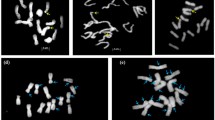Abstract
The present study is aimed to identify genetic variability between two species of Amaranthus viz., A. caudatus and A. hybridus subsp. cruentus, two economically important species, cultivated mainly for grain production. Karyomorphological studies in Amaranthus are scarce, probably due to higher number of small sized chromosomes. Karyomorphological studies were conducted using mitotic squash preparation of young healthy root tips. Karyological parameters and karyotypic formula were established using various software programs and tabulated the karyomorphometric and asymmetry indices viz., Disparity index, Variation coefficient, Total forma percentage, Karyotype asymmetry index, Syi index, Rec index, Interchromosomal and Intrachromosomal asymmetry index and Degree of asymmetry of karyotypes. The mitotic chromosome number observed for A. caudatus was 2n = 32 with a gametic number n = 16 and A. hybridus subsp. cruentus was 2n = 34 with a gametic number n = 17. In A. caudatus the chromosome length during somatic metaphase ranged from 0.8698 to 1.7722 μm with a total length of 39.1412 μm. In A. hybridus subsp. cruentus the length of chromosome ranged from 0.7756 to 1.9421 μm with a total length of 44.9922 μm. Various karyomorphometry and asymmetry indices analyzed revealed the extend of interspecific variation and their evolutionary status.



Similar content being viewed by others
References
Abraham Z, Prasad PN (1983) A system of chromosome classification and nomenclature. Cytologia 48:95–101
Anil SR, Suhara Beevy S, Siril EA (2013) Karyosystematic studies in Amorphophallus Blume ex Decne. J Root Crops 39:39–50
Arno H (1963) Cytological studies in subfamily Carduoideae (Compositae) of Japan. IX. The karyotype analysis and phylogenetic considerations on Pertya and Ainsliaea. Bot Mag (Tokyo) 76:32–39
Bressani R (1989) The proteins of grain amaranths. Food Res Int 5:213–238
Grant WF (1959a) Cytogenetic studies in Amaranthus: I. Cytogenetical aspects of sex determination in dioecious species. Can J Bot 37:413–417
Grant WF (1959b) Cytogenetic studies in Amaranthus: II. Natural interspecific hybridation between Amaranthus dubius and A. spinosus. Can J Bot 37:1063–1070
Grant WF (1959c) Cytogenetic studies in Amaranthus: III. Chromosome numbers and phylogenetic aspects. Can J Genet Cytol 1:313–318
Greilhuber J, Speta F (1976) C-banded karyotypes in the Scilla hohenackeri group, S. persica and Puschkinia (Liliaceae). Plant Syst Evol 126:149–188
Guerra M (2008) Chromosome number in plant cytotaxonomy:concepts and implications. Cytogenet Genome Res 120:339–350
Hauptli H, Jain S (1984) Biosystematics and agronomic potential of some weedy and cultivated amaranths. Theor Appl Genet 69:155–165
Huziwara Y (1962) The karyotype analysis in some genera of Compositae X: the chromosome of some European species of Aster. Bot Mag 75:143–150
Kolano B, Pando LG, Maluszynska J (2001) Molecular cytogenetic studies in Chenopodium quinoa and Amaranthus caudatus. Acta Soc Bot Pol 70:85–90
Mohanty BD, Ghosh PD, Maity S (1991) Chromosome analysis in cultured cells of barley (Hordeum vulgare L.): structural alterations in chromosomes. Cytologia 56:191–197
Pal M, Pandley RM, Khoshoo TM (1982) Evolution and improvements of cultivated Amaranths IX. Cytogenetic relationships between the two basic chromosome numbers. J Hered 73:353–356
Pal M, Ohri D, Subrahmanyam GV (2000) A new basic chromosome number for Amaranthus (Amaranthaceae). Cytologia 65:13–16
Sammour RH, Radwan SA, Mira M (2012) Genetic diversity in genus Amaranthus: from morphology to genomic DNA. Res Rev Biosci 6:351–360
Sauer JD (1967) The grain amaranths and their relatives: a revised taxonomic and geographic survey. Ann Mo Bot Gard 54:102–137
Srivastava R, Roy BK (2014) A new chromosome number for Amaranthus blitum. JNBR 3:111–114
Stebbins GL (1971) Chromosomal evolution in higher plants. Edward Arnold (Publishers) Ltd, London
Tucker JΒ (1986) Amaranth: the once and future crop. Bioscience 36:9–13
Venora G, Blangiforti S, Castiglione MR, Pignone D, Losavio F, Cremonini R (2002) Chromatin organization and computer aided karyotyping of Triticum durum Desf. Cv. Timilia. Caryologia 55:91–98
Verma BN (1980) Karyotype analysis in three species of Rhizoclonium Kütz. Cytologia 45:433–440
Watanabe K, Yahara T, Denda T, Kosuge K (1999) Chromosomal evolution in the genus Brachyscome (Asteraceae, Astereae): statistcal tests regarding correlation between changes in karyotype and habit using phylogenetic information. J Plant Res 112:145–161
Zarco CR (1986) New method for estimating karyotype asymmetry. Taxon 35:526–530
Acknowledgements
First author kindly acknowledges Kerala State Council for Science, Technology and Environment for providing financial assistance through KSCSTE fellowship.
Author information
Authors and Affiliations
Corresponding author
Ethics declarations
Conflict of interest
The authors declare that there are no conflicts of interest.
Rights and permissions
About this article
Cite this article
Prajitha, V., Thoppil, J.E. Cytogenetic characterization of Amaranthus caudatus L. and Amaranthus hybridus subsp. cruentus (L.) Thell.. Cytotechnology 70, 95–101 (2018). https://doi.org/10.1007/s10616-017-0100-9
Received:
Accepted:
Published:
Issue Date:
DOI: https://doi.org/10.1007/s10616-017-0100-9




